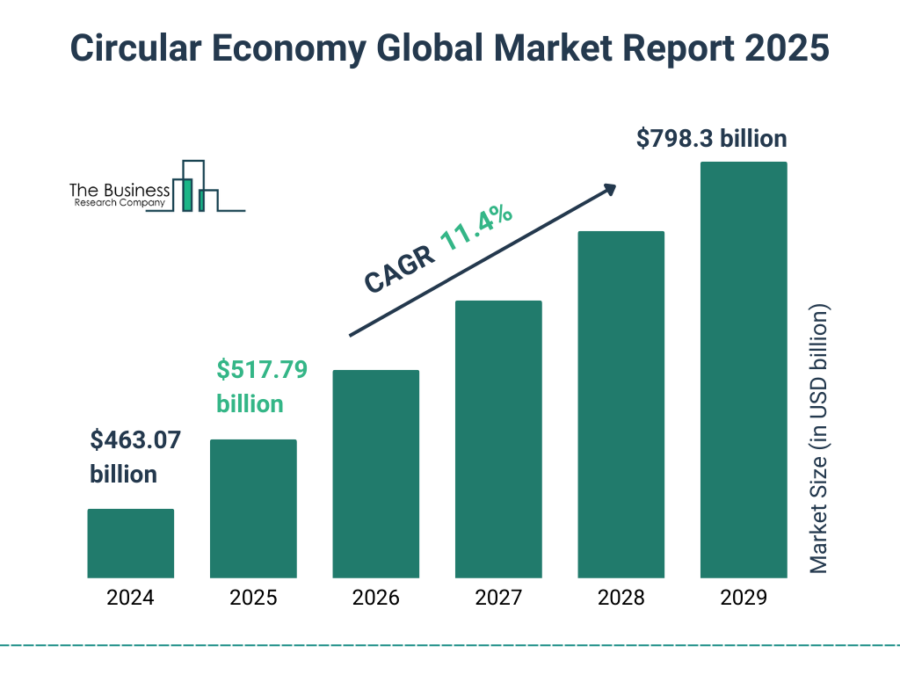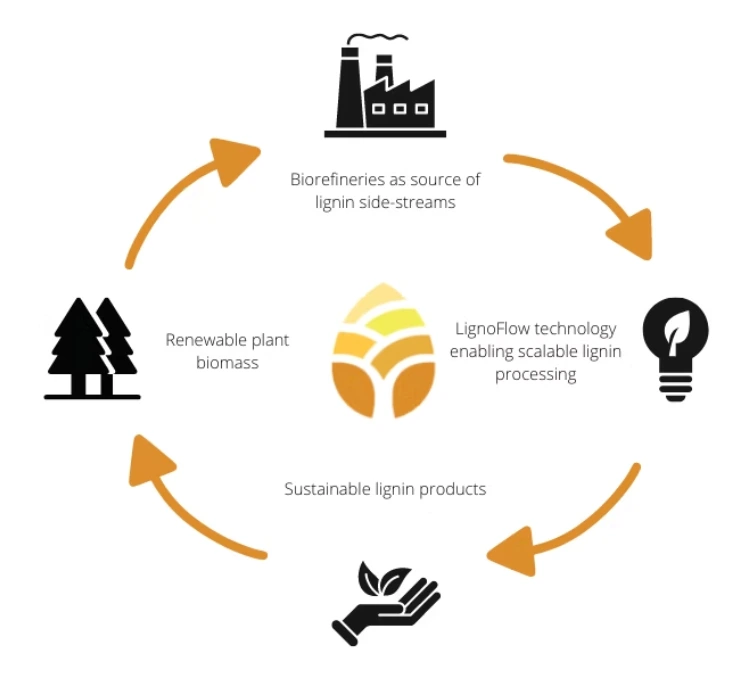The material trends are driven by technological advancements and a focus on sustainability. Innovations like generative AI, 3D printing materials, and bio-based alternatives are reshaping product development and manufacturing.
The adoption of circular economy principles, lightweight composites, and carbon capture technologies highlights the industry’s commitment to environmental responsibility. These trends are propelling market growth. The global materials market is projected to expand to USD 121.76 billion by 2033, at a compound annual growth rate (CAGR) of 5.92%.
This article explores the top 10 trends impacting the materials industry and highlights 20 emerging startups leading these innovations, showcasing how companies are leveraging these shifts for lasting competitive advantage.
What are the Top 10 Material Trends & Innovations in 2025?
- Generative AI Integration
- 3D Printing Materials
- Circular Economy
- Bio-based Materials
- Lightweighting
- Composites
- Carbon Capture Integration
- Industrial Automation
- Smart Materials
- Nanomaterials
Methodology: How We Created the Material Trends Report
For our trend reports, we leverage our proprietary StartUs Insights Discovery Platform, covering 5M+ global startups, 20K technologies & trends plus 150M+ patents, news articles, and market reports.
Creating a report involves approximately 40 hours of analysis. We evaluate our own startup data and complement these insights with external research, including industry reports, news articles, and market analyses. This process enables us to identify the most impactful and innovative trends in the materials industry.
For each trend, we select two exemplary startups that meet the following criteria:
- Relevance: Their product, technology, or solution aligns with the trend.
- Founding Year: Established between 2020 and 2025.
- Company Size: A maximum of 200 employees.
- Location: Specific geographic considerations.
This approach ensures our reports provide reliable, actionable insights into the materials innovation ecosystem while highlighting startups driving technological advancements in the industry.
Innovation Map outlines the Top 10 Material Trends & 20 Promising Startups
For this in-depth research on the Top 10 Materials Trends & 20 Startups, we analyzed a sample of 10 300+ global startups & scaleups. The Materials Innovation Map created from this data-driven research helps you improve strategic decision-making by giving you a comprehensive overview of the materials industry trends & startups that impact your company.

Tree Map reveals the Impact of the Top 10 Material Trends
The Materials TreeMap highlights the Top 10 Trends shaping 2025. These include AI material generator engines, PEN filaments, biodegradable polymer production, and green molding compounds. Other key trends are smart factory automation, direct-to-consumer models, graphene and fullerene nanomaterials, low-carbon construction materials, and bio-aerogels. Together, these trends are developing products and business operations across the materials market.

Global Startup Heat Map covers 10 300+ Materials Startups & Scaleups
The Global Startup Heat Map showcases the distribution of materials startups and scaleups analyzed using the StartUs Insights Discovery Platform. It highlights high startup activity in the United States and India, followed by the United Kingdom. From these, 20 promising startups are featured below, selected based on factors like founding year, location, and funding.

Want to Explore Materials Innovations & Trends?
Top 10 Material Trends in 2025
1. Generative AI Integration
Traditional experimental methods like trial-and-error testing for chemical reactions, structural durability, and thermal resistance are expensive and time-consuming. In contrast, generative AI rapidly predicts and designs novel materials with specific properties. For example, Google DeepMind’s new AI has created over 700 new materials, which reduced product development costs.
Similarly, material and structure optimization is vital to meet specific performance criteria and minimize waste. Through generative design principles, AI creates lightweight and efficient materials.
AI also enables the creation of materials and products tailored to specific consumer needs. A notable example is the fashion industry, where AI-driven platforms like Style DNA provide personalized styling recommendations.
Presently, the generative AI in the material science market size is expected to grow from USD 1.68 billion in 2025 to USD 5.35 USD in 2029 at a compound annual growth rate (CAGR) of 33.6%.

Credit: The Business Research Company
However, solutions like materials informatics are improving how data is utilized in materials science. Institutions like the Rice Advanced Materials Institute (RAMI) are integrating computational modeling and AI to accelerate materials discovery and design.
AI is also improving process engineering in materials development by digitizing legacy workflows and automating complex tasks such as process design and hazard analysis.
In material manufacturing environments, AI streamlines synthesis routes, optimizes reaction conditions, and predicts potential risks through tools like AI-assisted hazard and operability studies (HAZOPs).
Virtual seminars, like the one hosted by the Mid-Michigan Section of AIChE, showcase how AI applies to material-specific process engineering challenges. It is driving safer and faster innovation across sectors like chemicals, composites, and advanced materials.
Additionally, generative AI is utilized for the identification and design of new materials by predicting molecular structures with desired properties. For example, Amazon has partnered with Orbital Materials to pilot an AI-designed material to remove carbon in data centers.
Moreover, generative AI is enabling the development of advanced materials like metal-organic frameworks (MOFs) for environmental applications. Companies like Atoco use reticular materials, such as metal-organic frameworks (MOFs), for efficient carbon capture.
Similarly, researchers at Argonne National Laboratory are employing AI to identify environmentally friendly MOF materials.
Sareta offers an AI Engine for Material Discovery Generation
Sareta is a Canadian startup that employs generative AI and deep learning models to design new materials. It simulates natural formation processes to enable the discovery of novel compositions with desirable properties.
Through synthetic data generation, inverse design algorithms, and reinforcement learning, Sareta replicates natural formation processes in laboratory settings while providing deeper insights into material behaviors.
By automating fabrication processes, the startup also improves production facilities to meet the global demand for efficient and consistent material manufacturing.
It further improves material development at scale by integrating simulation, optimization, and automated experimentation into a unified pipeline. This enables faster prototyping, validation, and deployment of materials.
Multiscale Technologies facilitates Semiconductor Design & Fabrication
US-based startup Multiscale Technologies develops MIND, an AI platform that allows material companies to build and manage digital twins of advanced materials, chip architectures, and fabrication processes.
The platform replicates complex material behaviors under real-world manufacturing conditions and interprets high-dimensional data such as atomic-scale interactions, stress responses, and more.
Moreover, this platform integrates centralized digital asset management to organize material specifications, simulation outputs, and fabrication process data in one place.
It also streamlines development through automated workflows that reduce the need for repeated material testing, while no-code tools simplify AI/ML adoption.

Additionally, its closed-loop automation connects R&D and manufacturing environments, allowing instant decision-making based on real-time data.
By enabling horizontal AI adoption, MIND connects materials scientists, chip designers, and process engineers to improve material discovery and device fabrication.
2. 3D Printing Materials
3D printing materials are innovating how products are designed, manufactured, and consumed. By enabling rapid prototyping, localized production, and customization, these materials are improving supply chains and driving sustainability.
Fishy Filaments is reducing reliance on virgin materials by recycling discarded fishing nets into high-quality nylon, which is then used in 3D printing applications.
Also, 3D printing materials enable consumers to have intricate designs and personalized products. This technology improves the prototyping process and reduces production time. Czinger’s 21C hypercar uses 3D printing and AI to streamline manufacturing and enable the efficient production of high-performance vehicles.
Similarly, Nike introduced the Air Max 1000, its first shoe that is crafted using 3D printing technology.
Moreover, 3D printing reduces the need for extensive inventories and complex supply chains as this technology promotes localized production. SPEE3D’s metal 3D printing technology allows for the rapid fabrication of critical vehicle parts and supports military operations by enabling on-site manufacturing.
Technologies like the RecycleBot convert waste plastics into 3D printing filament while promoting sustainability and reducing reliance on virgin materials. For example, the Artme3D MK2, a DIY filament extruder, enables businesses to recycle 3D printing waste into usable filament.
Additionally, fused filament fabrication (FFF) is another 3D printing method that allows for the use of thermoplastics to create intricate designs and customized products. Xenia Materials introduces new high-performance filaments for FFF 3D printing.
Selective laser melting (SLM) is another 3D printing technique that uses lasers to fuse metal powders while facilitating on-demand manufacturing and supply chain optimization. Aerospace companies like SpaceX, Rocket Lab are adopting SLM to produce lightweight components for fuel efficiency.
Further, solutions like design for additive manufacturing (DfAM) involve designing products specifically for rapid prototyping and efficient material production.
FLXR Engineering makes Polyethylene Naphthalate (PEN) Filaments
FLXR Engineering is a Taiwanese startup that manufactures the MIXR, an eco-friendly magnetic stir bar redesigned from scratch to improve laboratory mixing efficiency.
The MIXR utilizes Daruma (roly-poly) motion to reduce vortex formation and to improve turbulence for mass and heat transfer during mixing processes.
The startup optimized the MIXR for various viscosities and mixing needs by combining business feedback, CFD simulations, and real-world testing. This design offers impeller-like mixing without the need for an overhead mixer.
Moreover, the MIXR series includes various models, such as the beetle (SBE), rolling stone (SRS), and petit prince (SPP), each customized for specific vessel types and mixing requirements.
FGF Technology enables Polymer Granules-based Additive Manufacturing
FGF Technology is a Dutch startup that specializes in additive manufacturing solutions utilizing polymer granules.
Its product line includes FGFT Recycled PETG, Polypropylene, ASA, and ABS. Businesses apply each material for prototyping, functional parts, and outdoor products, using acrylonitrile styrene acrylate (ASA) or polypropylene for durability in harsh conditions.

The startup also offers optimal printability and mechanical properties for diverse 3D printing projects. This includes large-scale parts, customized end-use products, and more.
Further, FGF Technology provides detailed material documentations like material safety data sheets (MSDS) and technical data sheets (TDS), among others.
It also includes proof of concept services and 3D printer consultancy to support the successful manufacturing of 3D-printed end products.
3. Circular Economy
Finite natural resources are depleting at an unsustainable rate. To address this, businesses are adopting circular economy principles to reduce the need for virgin resource extraction and to encourage the continual use of materials.
For instance, Taiwanese companies like Miniwiz and LOTOS are converting waste materials, such as insect shells and rice husks, into sustainable construction products. This reduces the carbon footprint of new construction materials.
Additionally, traditional linear production models contribute to pollution and greenhouse gas emissions. Circular practices, such as recycling and reusing materials, lower these environmental footprints.
Queen’s University Belfast’s QUILL research centre is developing methods to recycle rare earth metals from industrial waste using ionic liquid technologies.
Reflecting these advancements, the circular economy market size is expected to grow from USD 517.79 billion to USD 798.3 billion in 2029 at a CAGR of 11.4%.

Credit: The Business Research Company
Artificial intelligence (AI) systems improve the efficiency and accuracy of sorting recyclable materials while improving the quality of recycled outputs. An autonomous AI-enabled industrial sorting pipeline is improving textile recycling processes while addressing inefficiencies in traditional methods.
Moreover, biological processes offer sustainable alternatives to conventional material manufacturing. Natsai Audrey Chieza, a biomaterial designer, uses bacteria for eco-friendly dyeing processes and contributes to sustainable fashion practices.
Further, additive manufacturing through the use of recycled inputs allows for the creation of new products while minimizing waste. For instance, Architect Arthur Mamou-Mani is known for using parametric design and 3D printing with recycled materials.
Lemki Robotix is a Ukrainian-German startup that created a 3D-printed compact camper van by using plastic sourced from recycled bottles.
Evoralis expedites Plastic Recycling with Biocatalysts
UK-based startup Evoralis develops specialized enzymes that depolymerize plastics such as polyester (PET), nylon (PA), and elastane (PUR) into their original monomers.

Utilizing a patent-pending microfluidic ultra-high-throughput screening platform, the startup rapidly discovers and optimizes effective enzymes that reduce development time.
Moreover, Evoralis enables the recycling of textiles, including mixed and blended fibers. This addresses the challenge of separating and processing complex fiber combinations that traditional recycling methods cannot efficiently handle.
Rethread Africa produces Biodegradable Polymer
Rethread Africa is a Kenyan startup that changes agricultural waste into sustainable, biodegradable textile materials.
It utilizes post-harvest agro-waste, such as sugarcane bagasse, to produce polyhydroxyalkanoates (PHA) through fermentation with bacillus species. This process yields textiles that are recyclable and naturally decompose if discarded.
Additionally, blending PHA with natural fibers improves tensile strength and adds water resistance, making the materials suitable for activewear and outdoor apparel.
Further, Rethread Africa’s CottonCycle initiative employs hydrothermal and dissolution treatments to recycle post-consumer polyester and cellulose blends. This process recovers polyester fibers by reducing energy consumption.
This initiative also converts cotton into a cellulosic superabsorbent polymer (C-SAP). The material absorbs its weight in water while improving soil moisture retention and cotton yields in water-scarce regions.
4. Bio-based Materials
Businesses are reducing their reliance on fossil fuels and lowering their carbon footprint by adopting bio-based materials derived from renewable resources.
For instance, the fashion industry is introducing plant-based leather alternatives, such as those developed by Modern Meadow, which utilizes biofabrication techniques to create sustainable materials.
Also, many bio-based materials are designed to be biodegradable to address the persistent issue of plastic pollution. AMSilk produces synthetic silk biopolymers that are biocompatible and biodegradable.
Showcasing these major developments, the bio-based materials market size is expected to grow from USD 47.97 billion in 2025 to USD 106.69 billion in 2029 at a CAGR of 22.1%.

Credit: The Business Research Company
Bio-based polymers serve as sustainable alternatives to conventional plastics. The biopolypropylene market is projected to reach USD 116.03 million by 2029, growing at a CAGR of 29.0%.
Moreover, advanced recycling methods, such as those employed by Exxon Mobil Corp, convert plastic waste back into its original monomers. It also plans to invest USD 200 million to expand its Texas plants and to process up to 1 billion pounds of plastic waste annually by 2027.
Enzymatic recycling also allows for the breakdown of plastics, such as nylon 6, into their constituent monomers for infinite recycling without quality loss.
Further, microbial biofabrication uses microbes to produce materials. Shellworks is developing biodegradable materials, such as Vivomer, that are derived from microbial sources. This offers sustainable alternatives to traditional plastics.
In addition, algae-based material serves as a renewable feedstock for producing biodegradable plastics and biofuels.
Mycelium composites also offer biodegradable alternatives for packaging and construction by contributing to waste reduction and sustainability.
Lignoflow Technologies enhances Lignin Processing
Lignoflow Technologies is a Swedish startup that has developed its patented technology, LignoFlow, for processing lignin into scalable bio-based materials.

Its LignoFlow technology facilitates lignin processing in a water-efficient, high-consistency, and flowable gel state without covalent chemical reactions. This method works for most technical lignin grades that enable dust-free processing and mass transfer.
Moreover, it is readily scalable and compatible with existing industrial processes and circular bio-economy concepts.
NanoPlume develops Bio-Aerogels
UK-based startup NanoPlume develops super-insulating bio-aerogels and facilitates scalable manufacturing processes. It does so through ambient drying processes and modular fabrication techniques.
It also utilizes recycled biopolymers, such as cellulose, and natural feedstocks to create lightweight, thermally efficient materials. These bio-aerogels require only a fraction of the thickness compared to traditional insulators like mineral wool to achieve similar energy efficiency.
They are biodegradable, strong, reusable, and recyclable, which aligns with circular economy principles.
5. Lightweighting
Lighter materials require less energy to operate, leading to improved fuel economy and lower greenhouse gas emissions. For example, 10% reduction in vehicle weight results in a 6%-8% improvement in fuel economy.
Also, reducing the weight of materials means using less raw material, which leads to cost savings in manufacturing. This also lowers material costs and decreases energy consumption during production.
In addition, lighter structures contribute to better acceleration, braking, and handling. This improves the performance characteristics of vehicles and aircraft, making them more responsive and efficient.
Solutions like advanced high-strength steels (AHSS) offer superior strength-to-weight ratios, allowing manufacturers to reduce material thickness without compromising structural integrity. For example, the automotive lightweight materials market, which heavily relies on these steels, is projected to reach USD 100.31 billion by 2025.
Moreover, the integration of carbon fiber reinforced polymers (CFRP) and glass fiber reinforced polymers (GFRP) offers weight reductions while maintaining strength and durability.
Hot form quench (HFQ) technology also allows the creation of complex, high-strength components through a process of heating, forming, and rapid cooling. HFQ enables the production of lightweight structures that replace heavier materials.
Further, the development of materials at the nanoscale, such as layered metamaterials with thermal and mechanical properties, offers ultra-low thermal conductivity and high mechanical rigidity. These innovations are offering super-insulating materials that are suitable for extreme environments and lightweight aerospace structures.
Researchers have designed layered honeycomb-structured metamaterials using zirconia that achieve ultra-low thermal conductivity of 12.5 mW/(m·K) while maintaining high mechanical rigidity.
Antefil Composite Tech makes Microengineered Hybrid Fibres
Antefil Composite Tech is a Swiss startup that develops micro-engineered hybrid fibers for lightweight structures.
The startup individually coats glass reinforcement fibers with a meltable, recyclable plastic during the fiber spinning process. This creates materials that integrate both reinforcement and matrix components at the microscale.
Moreover, this method eliminates the need for traditional resin infusion, enabling rapid and energy-efficient production of fiber-reinforced plastics.
By simplifying the manufacturing process and improving recyclability, Antefil Composite Tech provides a cost-effective and sustainable solution for producing high-quality lightweight composites across industries.
fibclick designs Fiber-reinforced Material Production Software
fibclick is a German startup that automates production planning for composite manufacturing through its computer-aided design (CAD) software system.
This software automatically constructs tools and setup plans by designing fiber and textile guidance and generating assembly plans. It also provides an augmented reality (AR)-based threading aid for fiber placement.

Additionally, this software enables the production of complex profiles without requiring in-depth process expertise. fibclick further improves process stability through material simulations that reduce planning costs.
It decreases pultrusion line setup times with automated plans and AR threading aids. The software also minimizes material waste by optimizing fiber guidance and tool design.

6. Composites
Industries like aerospace and automotive prefer materials that reduce weight and improve fuel efficiency and performance. Composites such as carbon fiber-reinforced polymers (CFRPs) cater to this as they are lighter than metals but carry significant strength.
For instance, Richard Mille, in collaboration with North Thin Ply Technology (NTPT), has developed watch cases using composites like carbon thin ply technology (TPT) and quartz TPT. These materials provide strength and lightness while offering aesthetic patterns.
Another instance is the Boeing 787 Dreamliner that utilizes CFRPs, with composites accounting for approximately 50% of the aircraft’s structure.
Composites are also resistant to corrosion, which makes them ideal for applications exposed to harsh environments, such as chemical processing equipment and marine structures.
In addition, composites are moldable into complex shapes that allow for innovative designs and part consolidation. This reduces the number of components and simplifies assembly processes.
Solutions like ceramic matrix composites (CMCs) consist of ceramic fibers embedded in a ceramic matrix that offers high-temperature stability and resistance to wear and corrosion.
3D printing and artificial intelligence (AI) are improving the production of composite materials by creating complex geometries and optimized structures that were previously unattainable. Czinger, an automotive company, has developed the 21C hypercar using a combination of 3D printing and AI.
Moreover, the development of bio-based and sustainable composites maintains desirable properties, such as strength and durability, while reducing environmental impact.
For example, the automotive industry is adopting bio-based composites for interior components. These materials combine flax and hemp fibers with bio-resins to produce sustainable and lightweight parts.
Further, metal matrix composites (MMCs) consist of metal alloys with ceramic or other fibers that combine the ductility of metals with the strength and stiffness of ceramics. For instance, CPS Technologies is developing MMCs using aluminum with ceramic fibers for the aerospace and automotive sectors.
bespline enhances Adaptive Molding System
bespline is a Canadian startup that utilizes an adaptive molding system to create complex curved composite materials.
This technology employs a membrane atop digitally controlled actuators to form precise singly and doubly-curved surfaces directly from 3D computer-aided design (CAD) files.
By eliminating traditional mold requirements, bespline reduces time, cost, and material waste.
The technology also accommodates materials like foam cores, wood veneers, and fiber-reinforced laminates, which improves its versatility across applications.
Hikari provides Green Moulding Compound
Hikari is an Italian startup that develops the Green Moulding Compound (GMCs), which is an eco-friendly composite material composed of natural fibers, bio-resins, and biofillers.
This material offers a carbon footprint approximately half that of traditional composites. One notable application of GMC is Hedera which is an indoor vertical garden that allows businesses to cultivate a variety of plants, from vegetables to tropical species.
Moreover, Hedera serves as a design element for interiors that regulate humidity and act as an air purifier.
7. Carbon Capture Integration
Steel, cement, and chemical industries – all vital to the materials sector are the major sources of carbon emissions. Implementing carbon capture, utilization, and storage (CCUS) reduces these emissions and supports global climate goals without halting material production.
Also, adopting CCUS meets growing consumer and regulatory demands for low-carbon products while maintaining or improving market competitiveness.
Additionally, in the materials industry, where processes like cement calcination, steelmaking, and aluminum smelting emit CO₂, CCUS provides pathways for deep decarbonization without compromising material production efficiency.
Driven by such applications across high-emission material sectors, the global carbon capture and storage market size is expected to grow from USD 8.92 billion in 2025 to around USD 50.70 billion by 2034. It is also expanding at a CAGR of 21.37% from 2025 to 2034.

Credit: Precedence Research
Amine-based solvent carbon capture technology utilizes chemical solvents to absorb carbon from flue gases.
Metal-organic frameworks (MOFs) are highly porous materials that selectively capture carbon molecules. Nuada combined MOFs with solid sorbents improve carbon capture efficiency in sectors like cement.
Moreover, calcium looping involves cyclic calcination and carbonation of calcium-based sorbents to capture carbon. Calix developed a kiln enabling carbon from calcination to be driven off as a pure stream.
Direct air capture (DAC) also collects carbon directly from ambient air. Climeworks launched Mammoth in Iceland, which is a facility that captures up to 36K tons of carbon annually.
Further, cryogenic carbon capture separates carbon by cooling flue gases to low temperatures, while membrane separation methods use selective membranes to filter carbon from gas mixtures.
These solutions suit the materials industry, where high-temperature processes produce flue gases that resist conventional decarbonization.
NEEMA Labs delivers Plant-based Leather Alternative
NEEMA Labs is a Cypriot startup that develops VELO, which is a plant-based leather alternative derived from prickly pear cactus trimmings.
By partnering with local farmers, the startup collects waste trimmings, extracts useful ingredients, and processes them with natural additives to create durable, cactus-based leather.
This material is cruelty-free, synthetic polymer-free, and offers a sustainable and eco-friendly alternative to traditional leather.


Cocoon Carbon promotes Low-carbon Construction Materials
UK-based startup Cocoon Carbon develops a proprietary process that converts industrial waste into sustainable supplementary cementitious material (SCM). This reduces the carbon footprint of cement and also permanently sequesters carbon within the material.

By integrating waste materials and carbon into cement production, the startup further addresses the environmental challenges of the steel and cement industries.
Cocoon Carbon’s scalable process also offers manufacturers a cost-effective method to lower emissions and repurpose waste. This support the transition to low-carbon construction materials.
8. Industrial Automation
From sourcing raw materials to delivering finished products, automation improves efficiency, consistency, and quality at every step.
For instance, Amazon’s deployment of mobile robots and robotic arms across its warehouses has led to a 25% reduction in order fulfillment costs. Analysts project that these automation efforts are going to save Amazon up to USD 10 billion annually by 2030.
Automated systems also minimize human errors while offering consistent and precise execution of tasks, which improves material quality.
In addition, these systems handle hazardous or physically demanding tasks while reducing the risk of workplace injuries and maintaining steady material flow in production lines.
Automated guided vehicles (AGVs) are self-navigating vehicles that transport materials within facilities and reduce manual material handling and associated errors.
Takealot has deployed Geek+ robots in its South African facilities. These AGVs automate the movement of materials within warehouses, streamline operations, and reduce manual material handling tasks.
Automated storage and retrieval systems (AS/RS) are computer-controlled systems that automatically place and retrieve loads from defined storage locations.
Reflecting these innovations, the global AS/RS market is projected to grow from USD 10.65 billion in 2025 to USD 21.28 billion by 2034 with a CAGR of 7.41%.

Credit: Precedence Research
In material-intensive operations, vision-guided robotics identify, inspect, and handle materials with precision while reducing defects and ensuring consistent quality. These systems are particularly useful in tasks requiring high accuracy, such as assembly and packaging.
Further, manufacturing execution systems (MES) are computerized systems that monitor and control material production processes on the factory floor. These systems provide real-time data to optimize operations, improve material quality, and ensure regulatory compliance.
Matta is one such startup that specializes in implementing MES solutions to improve material production efficiency and material quality across manufacturing industries.
Kowasys facilitates Smart Factory Automation & Process Control
Malaysian startup Kowasys delivers smart factory automation and process control solutions that optimize raw material handling, inventory management, and production operations.
It offers customized automation systems to manage the transport, storage, and control of raw materials throughout the manufacturing process.
Its automated raw material inventory and dispensing systems offer precise measurement, correct sequencing, and accurate usage of ingredients.

The startup integrates hybrid smart batching systems that combine the flexibility of manual batching with the speed and accuracy of automated processes. This ensures precise formulation and consistent material quality.
Kowasys also provides bulk solids and powder handling equipment, including conveyors, silos, hoppers, and feeders. These are customized to match specific material production requirements.
Its customized filling and dosing systems are available in manual, semi-automatic, and fully automatic configurations to meet varying operational needs.
In addition, its integrated inventory management system monitors raw material and finished goods levels to prevent shortages and excess inventory.
The startup’s data logging and tracking system collects and stores real-time production and material usage data. This enable traceability and informed decision-making across all operational stages.
Polyfos 3D enables Multi-Material Polymer Additive Manufacturing
Polyfos 3D is an Israeli startup that develops a multi-material polymer additive manufacturing (AM) technology.
This technology enables the simultaneous printing of parts using a durable material for the main structure and a water-soluble material for support structures.
After printing, the support material dissolves in water, leaving behind smooth and clean parts without the need for manual post-processing.
Moreover, by eliminating labor-intensive post-processing, Polyfos 3D’s technology improves efficiency and productivity in 3D printing.
9. Smart Materials
Adopting smart materials addresses the frequent environmental changes and leads to improved energy utilization.
Electrochromic materials, for example, are used in smart windows to adjust their opacity in response to electrical stimuli. This controls the amount of light and heat passing through while it reduces the need for artificial lighting and air conditioning.
Incorporating smart materials like shape-memory alloys (SMAs) into structures also enables them to respond to stress. SMAs revert to their original shape after deformation, which is particularly beneficial in seismic-resistant constructions.
Additionally, smart materials reduce waste and promote eco-friendly practices. For example, biodegradable interactive materials, developed from natural substances like silk and dopamine, decompose naturally and minimize environmental impact.
Highlighting these innovations, the global smart materials market size is predicted to grow from USD 84.57 billion in 2025 to USD 169.62 billion by 2034, growing at a CAGR of 8.04%.

Credit: Precedence Research
Self-repairing or self-healing polymers and concrete are extending the lifespan of structures and products. These materials autonomously repair cracks and reduce maintenance costs.
For example, the UK developed a self-healing road surface to repair cracks autonomously, thereby preventing potholes and reducing maintenance costs.
Electroactive polymers (EAPs) are also used in flexible electronics and wearable devices. These materials react to electrical stimuli and allow dynamic shape changes.
LG is developing flexible, stretchable smart displays based on electroactive polymers (EAPs) for next-generation wearable devices.
Moreover, self-assembly materials are pivotal in nanotechnology and materials science that create complex structures with precision at the molecular or nanoscale level.
Scientists have utilized DNA as a building material to create nano-scale structures, such as a 150-nanometer-wide dinosaur model. This innovation demonstrates the potential of DNA self-assembly in developing nanobots for targeted drug delivery and smart materials.
Further, metamaterials manipulate light and sound waves while leading to applications like advanced imaging, cloaking devices, and noise reduction. Researchers at Stanford University have created an ultra-thin metamaterial cloak that renders objects nearly invisible under certain wavelengths.
Polymer Pavements improves Environmental Construction Management
Polymer Pavements is an Indian startup that specializes in developing and manufacturing smart materials for the mining and road construction industries.
Its product, SoilTech Mk. III, is a third-generation polymer binder for mine haul-road stabilization under heavy loading conditions and is now also utilized in commercial road design.
Dust-Tech is a liquid polymer with a 10-micron particle size, allowing for deep soil penetration to suppress dust.
PolySeal modifies cement to improve the tensile and flexural strength of mortars and concrete.
AsphalTech binds non-plastic materials into a durable wearing course seal to improve asphalt performance.
The startup also offers ClearTech, a transparent colored binder for surface binding of materials that create natural-looking wearing course seals, particularly in environments where aesthetics are important.
PolyCem is another cost-effective liquid polymer binder that requires no compaction and cures at room temperature. It allows waste or in-situ aggregates to bind into concrete-like slabs.
Further, Palletizer Binders are non-intrusive binders for waste fines or slurries, such as coal fines and slag materials. It converts the waste into usable briquettes.
PolyGel Clay Stabilizers is a two-component product that neutralizes the water absorption properties of clay and then binds and stabilizes the material into a water-resistant layer.
MNT SmartSolutions develops Nano-composites Toothbrush/Toothpaste
US-based startup MNT SmartSolutions provides sustainable smart materials with electronic and magnetic properties to advance science and medicine.
The startup’s nanotechnology-based interactive toothpaste and toothbrush combination utilizes nano-composites to treat and prevent microbial growth and plaque formation in the mouth.
These nano-composites are guided by magnetic gradients to target infected areas, disrupt biofilms, and provide sustained release of active agents over time.
Moreover, the smart toothpaste is remotely controlled by an electromagnetic field to move, scrub, and generate heat when used with the interactive toothbrush.
10. Nanomaterials
Nanomaterials improve the strength, durability, and flexibility of materials. For instance, integrating nanoparticles into composites is leading to stronger yet lighter automobile and bicycle parts.
Also, due to the high surface area-to-volume ratio of nanomaterials, they serve as efficient catalysts in chemical reactions. Platinum nanoparticles, for example, are being explored for use in automotive catalytic converters to reduce harmful emissions more effectively.
These nanomaterials develop high-performance energy storage systems. Their application in battery components increases energy density and faster charging times, which are crucial for the advancement of electric vehicles and portable electronics.
Carbon nanotubes (CNTs) are incorporated into materials to increase strength, durability, and flexibility. CNTs are utilized in the development of transistors and sensors due to their electrical conductivity and nanoscale dimensions.
An Indian startup, NoPo Nanotechnologies, is expanding its production capacities of single-walled carbon nanotubes (SWCNTs). It serves global battery manufacturers and supplies CNTs to chipmakers in Taiwan and Japan.
Moreover, MXenes, a class of two-dimensional transition metal carbides and nitrides, are improving the performance of batteries and supercapacitors.
Nanostructured catalysts with high surface area-to-volume ratios, such as platinum nanoparticles, serve as efficient catalysts in chemical reactions. They are vital in automotive catalytic converters, which reduce harmful emissions.
Further, biodegradable nanomaterials are being developed for drug delivery systems, allowing for targeted therapy with reduced side effects.
For instance, a biotech firm launched a nanoparticle-based drug delivery platform. It delivers chemotherapy drugs directly to tumor cells and minimizes damage to healthy tissues.
Nanostructured energy storage materials are also utilized in battery anodes and cathodes to improve energy density and charging speeds.
For example, Sicona Battery Technologies is innovating lithium-ion batteries by incorporating silicon, thereby reducing reliance on traditional graphite anodes.
Graphene Plus produces Graphene and Fullerene Nanomaterials
Graphene Plus is a Ukrainian startup developing advanced materials based on graphene and fullerene nanostructures.
The startup’s thermally reduced graphene oxide (TRGO) features chemically bound oxygen groups and two to five carbon planes. These improve adhesion to polymer binders and improve the strength, durability, and conductivity of composite materials.
Moreover, TRGO is well-suited for use in the automotive, aerospace, and construction industries.
Additionally, the startup offers hydrated fullerene C60 (HyFnC60), a molecular colloidal solution where each C60 molecule is encased in a shell of water molecules.
This supramolecular complex shows promise in biomedical, cosmetic, and environmental applications due to its stability and unique chemical properties.
Nanopob yields Bio-based Nanomaterials
Nanopob, a Thai startup, develops technology to convert methane and carbon dioxide from biogas into valuable bio-based nanomaterials. Their products include highly pure biographene in two forms, one with 3-8 layers and the other with 20-30 layers.
Additionally, it includes bio-rGO (reduced graphene oxide) with less than 10 layers. It also features bio-nanotubes (MWCNT-D1) with diameters of 20–30 nm and bio-nanotubes (MWCNT-D2) with diameters of 50–70 nm. These nanomaterials improve the energy density of energy storage devices and reduce charging times.
Further, these nanomaterials strengthen composites and coatings and advance electronic applications like transistors and sensors.
Discover all Material Trends, Technologies & Startups
As the materials industry evolves, companies adopt carbon capture, bio-based inputs, AI-driven design, and closed-loop systems. Startups and established players drive these innovations to deliver high-performance, sustainable materials. This, in turn, increases efficiency, strengthens resilience, and shapes the future of various industries, including manufacturing, construction, and mobility.
The Materials Trends & Startups outlined in this report only scratch the surface of trends that we identified during our data-driven innovation & startup scouting process. Identifying new opportunities & emerging technologies to implement into your business goes a long way in gaining a competitive advantage.










